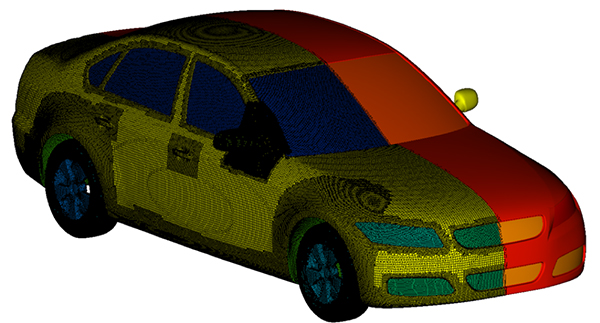Use of CF-MESH+ and OpenFOAM Helps Solve Turbulent Flow Simulation Around DrivAer Vehicle
CF-MESH+ is a fully automated CFD meshing software solution that features capabilities for mesh generation in arbitrary complex geometries.

The process of automatically generating a suitable mesh for automotive turbulent flow simulation was straightforward. Image courtesy of Creative Fields.
Latest News
March 1, 2019
Creative Fields reports that the turbulent flow simulation around the DrivAer vehicle was solved successfully using CF-MESH+in combination with ESI Group's OpenFOAM. CF-MESH+ is a fully automated CFD meshing software solution that features capabilities for mesh generation in arbitrary complex geometries.
The generic DrivAer model for external flow was introduced in 2011 to narrow the gap between the overly simplified models commonly used in automotive aerodynamics investigations (e.g. Ahmed body) and the highly complex production cars. CF-MESH+ was used to automatically generate a volume mesh around the DrivAer vehicle from a few simple specifications. The volume mesh was then successfully used in turbulent flow simulation around the vehicle by using OpenFOAM.
“We are proud of yet another successful case where CF-MESH+ has proven an excellent companion to OpenFOAM when it comes to automotive aerodynamics. Advanced boundary layer generation capabilities and the ability to control the layer thickness in the first cell near the wall make CF-MESH+ an ideal candidate for mesh generation in external aerodynamics simulations,” says Mario Baburic, managing director at Creative Fields.
The process of automatically generating a suitable mesh for automotive turbulent flow simulation was straightforward. DrivAer geometry was obtained and imported into CF-MESH+, where bounding box around the vehicle was added.
Each side of the bounding box was then named differently in order to define boundary conditions required by the simulation setup. The geometry of the DrivAer car was separated into multiple patches and set with different mesh refinement levels to enable feature edges to be automatically generated between patches in CF-MESH+ and allow for geometry details that require finer mesh resolution.
10 boundary layers were specified on the bottom surface of the bounding box and around the car geometry. A Cartesian volume mesh with 25 million cells (96% of which hexahedral) was obtained automatically by using CF-MESH+ (v2.2.1).
The automatically generated mesh has no sudden cell size change, instead every cell size change is resolved gradually, regardless of its position (further from the car geometry or in the boundary layer), which has a positive impact on the stability of the calculation and its convergence.
Generated mesh was then used for simulation of the incompressible turbulent air flow around the vehicle using OpenFOAM solver simpleFoam and k-ω SST turbulent model which achieved convergence after 400 iterations after which quasi-steady solution was obtained.
More Info
Sources: Press materials received from the company and additional information gleaned from the company’s website.
More ESI Coverage
Subscribe to our FREE magazine, FREE email newsletters or both!
Latest News
About the Author
DE’s editors contribute news and new product announcements to Digital Engineering.
Press releases may be sent to them via DE-Editors@digitaleng.news.






